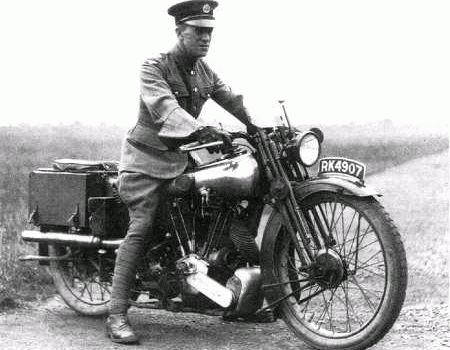FAMOUS MOTORCYCLISTS OF LAST CENTURY – PART I
Thomas Edward Lawrence
Thomas Edward Lawrence was a bit of a renaissance man.
He was a scholar of distinction.
He spent his university summer holidays in 1907 and 1908 touring France by bicycle, studying crusader castles. In 1909, he took a three month walking tour of Syria, studying crusader castles. He finished his degree with first class honours in 1910, after submitting an acclaimed thesis The Influence of the Crusades on European Military Architecture to the End of the 12th Century. He spent 1910 to 1911 as an archaeologist in the Middle East.
During his lifetime, he published four major literary works. Two were translations from Greek and French: The Odyssey and The Forest Giant. The others were Seven Pillars of Wisdom and an abridged version of that work, Revolt in the Desert.
He was a soldier of distinction.
In January 1914, the British could smell World War I in the air. The British Military sent Lawrence to map the Negev desert under cover of conducting an archaeological expedition. The area would have to be crossed by a Turkish army attacking Egypt. The expedition published a report for the academics and public, and provided a report to the British Army on items of military significance such as water supplies.
War broke out in August that year. Lawrence enlisted in October. His knowledge of the Arab people made him an ideal liaison officer between the Arab and British forces. A year later, he was sent into the desert to report on Arab Nationalist movements. He fought a guerrilla war with Arab irregulars against Ottoman soldiers. He formulated a strategy of containing Turkish troops rather than driving them out, forcing the Turks to leave large numbers of men in his area who could have been elsewhere fighting British troops.
In 1917 he arranged a joint action to take the port city of Aqaba in a daring overland attack from the desert, and was promoted to major.
In 1918 he was involved in the capture of Damascus, and was promoted to lieutenant-colonel. He was made a Commander of the Order of the Bath, and was awarded the Distinguished Service Order and the French Legion d’Honneur. In 1918 he refused to be made a Knight Commander of the Order of the Bath. King George V said “He left me there with the box in my hand”.
In his time with the Arab irregulars, he adopted many local customs, and wore Arab dress. He became a close friend of Prince Faisal.

Lawrence on one of his Brough Superior Motorcycles, Cranwell, 1925/26
After the war, he worked for the Foreign Office, spent much of 1921 as an advisor to Winston Churchill in the Colonial Office, attended the Paris Peace Conference, and joined the Royal Air Force under the name of Ross in 1922. When his cover was blown and he was kicked out, he changed his name to Shaw (after his good friend George Bernard Shaw) and joined the Royal Tank Corps the next year. He didn’t like it, and made a nuisance of himself until the Royal Air Force took him back in 1925, where he worked on high speed boats until he left in 1935.
Just before his death, his friend Lady Astor wrote to him “‘I believe when the Government reorganizes, you will be asked to reorganize the defence forces.”
And he was a motorcyclist of distinction.
Lawrence had a taste for superbikes. Brough Superiors were rare and expensive. George Brough made 3048 motorcycles in 19 models between 1919 and 1940. He never made more than 212 bikes a year. In 1940, he made just 10 before switching to making parts for Spitfires.
Brough Superiors were dubbed “The Rolls-Royce of Motorcycles”.
Brough Superiors had innovations. A Brough Superior was the first motorcycle EVER to have a side stand. It was the first motorcycle to have a ride-off centre stand.
Brough Superiors were mostly 1000cc V-twins. The SS100 had overhead valves. There was even a shaft drive flat four in 1938. George called it the Dream. Honda made a bike which they called the Dream in 1961. It took until 1975 before they made a flat four with shaft drive.
Brough Superiors were superbikes.
In 1928, George Brough recorded 130.6mph (210km/h) on an SS100 at Arpajon.
In 1938, a Brough Superior hit 180mph (289km/h) at Budapest. The record wasn’t accepted officially — Eric Fernihough, the rider, crashed and was killed on the return run.
Lawrence owned lots of Brough Superiors. Seven, in fact.
He was a personal friend of George Brough. He named his bikes George I, George II, George III, George IV, George V, George VI and George VII. George VIII was on order when Lawrence died in March 1935. Lawrence customized his motorcycles. It was having the stainless steel petrol tank fitted.
The Georges were more numbers than names. Lawrence always referred to his current Brough as Boa. Short for Boanerges: Son of Thunder.
And, like Piet, he could always make a case for owning a very expensive motorcycle. His opinion of the Brough Superior SS100 is well stated in his letter to George:
27.9.26
Dear Mr. Brough,
Yesterday I completed 100000 miles, since 1922, on five successive Brough Superiors, and I’m going abroad very soon, so that I think I must make an end, and thank you for the road-pleasure I have got out of them.

A later Brough: undated
Your present machines are as fast and reliable as express trains, and the greatest fun in the world to drive: – and I say this after twenty years experience of cycles and cars.
They are very expensive to buy, but light in upkeep (50-65 m.p.g. of petrol, 4000 m.p.g. oil, 5000-6000 miles per outer cover, in my case) and in the four years I have made only one insurance claim (for less than £5) which is a testimony to the safety of your controls & designs. The S.S.100 holds the road extraordinarily. It’s my great game on a really pot-holed road to open up to 70 m.p.h. or so and feel the machine gallop: and though only a touring machine it will do 90 m.p.h at full throttle.
I’m not a speed merchant, but ride fairly far in the day (occasionally 700 miles, often 500) and at a fair average, for the machine’s speed in the open lets one crawl through the towns, & still average 40-42 miles in the hour. The riding position & the slow powerful turn-over of the engine at speeds of 50 odd give one a very restful feeling.
There, it is no good telling you all you knew before I did: they are the jolliest things on wheels.
Yours very sincerely
T E LAWRENCE
And in another letter, six years later:
5. 3. 32 Hythe, Southampton
Dear Mr. Brough,
It is the silkiest thing I have ever ridden: partly because of the perfect tune, partly from the high gear: but mostly because of the spring sprocket, I suppose. The gear is not too high. I can get down to 16 m.p.h.: and she pulls fairly at 30 m.p.h: and at 50 she is a dream. Just popples along so mildly that I can count the revs.
It was very cold but a beautiful ride. The back plug lasted till I got to Welwyn. The second plug is still running. I took two from your stores: so have made the cheque for 10/- extra, which I hope will cover them.
I think this is going to be a very excellent bike. The crowds that gape at her, just now, will stop looking after she gets dirty: and that may be soon, if only the R.A.F. give me spare time enough to use the poor thing.
I am very grateful to you and everybody for the care taken to make her perfect.
Yours ever
T E SHAW
Another of his friends was Lady Astor. Nancy Astor was known to ride pillion with Lawrence. Back then the rear seat was called the “flapper seat”. She was a leading socialite of the time, and the first female member of the British House of Commons.
On New Years Eve of 1930, Lawrence wrote:
I feel inclined to send a postcard to Sandwich [an address of Lady Astor’s], explaining how much I enjoyed Cliveden and what an excellent ride back I had (including a race across the Plain with a sports Bentley: well, not so much a race as a procession for the Bent, which did only 88. I wished I had a peeress or two on my flapper bracket!)
His contemporaries remembered his motorcycles. The novelist Henry Williamson said in an interview in 1962: “‘Finally he turned up one Sunday, coming right across Dartmoor from Plymouth to North Devon, where I lived, on his ten horse power 100 mile an hour Brough Superior nickel-plated motor cycle ….”
The same year, Siegfried Sassoon said “He was almost like a too high powered motor bicycle, almost over-powered …. To call him a charlatan as some people have done is a wicked representation of the worst possible kind. Everything I know of his character belies it. He was absolutely true mettle all through.”
Lawrence knew he was over-powered.
On May 3, 1934, he wrote in a letter to his friend George Brough:
It looks as though I might yet break my neck on a BS.
Twenty two months later, on May 13, 1935, while punting Boa along a country road, he swerved to avoid hitting two young boys on bicycles, lost control, and was thrown over the handlebars of his motorcycle.
He died six days later. He was 43.

Boa at the National Motor Museum at Beaulieu in Hampshire, UK









